Amazing Life Planner: Part 2
In the previous post in the Living an Amazing Life series, I shared with you the first three steps to creating an amazing life plan.
There’s still work to be done, so here are the next three…
4. Get advice from Young You, Old You, and Game-Over You
12-Year-Old Wisdom: Imagine describing your life so far to a 12-year old version of yourself. What changes would that child want you to make right now? Fill out the 2nd row on the Amazing Life Grid.
82-Year-Old Wisdom: Imagine describing your life so far to an 82-year old version of yourself. What changes would that 82-year old want you to make right now? Fill out the 3rd row on the Amazing Life Grid.
Game-Over Wisdom: Nothing is quite as clarifying as mortality. If you knew this is your last year on this great planet, how you spend your days? What would you stop doing? Fill out the 4th row on the Amazing Life Grid.
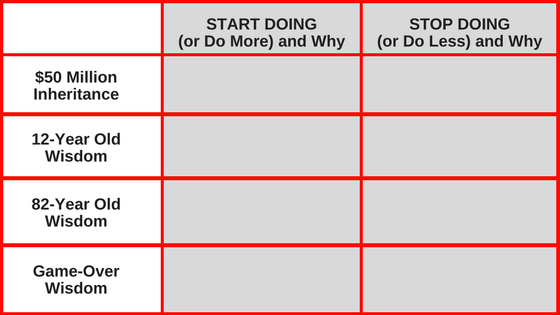
5. Put it all together: Your Amazing Life Plan Ner
Take what you’ve learned from the previous exercises. What themes or patterns do you notice?
Action
Based on what you learned from the previous exercises, fill out the Amazing Life Plan. Choose your top three “achievement” and top three “enjoyment” goals for the next 12 months.
Tip: Start with the ‘Self’ category.
AMAZING LIFE PLANNER
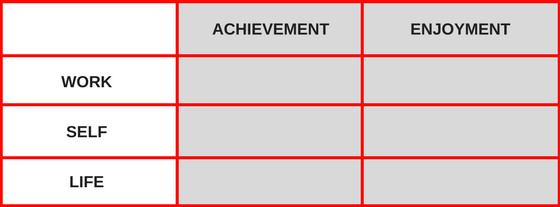
6. Build a better plan, and plan ahead – well ahead
An amazing life takes commitment and organization. You will only have a great life if you schedule things that make it great and stick to those commitments.
This is why my wife and I start each year knowing where we’ll take our vacations. We make our bookings for the coming year in December, if not earlier. Whatever your favourite activities are, start planning them. Book the concerts, brunches and dinner parties. Commit to your date nights. Schedule your volunteer time.
Of course, if you’re the rare person who can be spontaneous with all your personal activities and run a booming business, my hat is off to you. But most of us need sound planning to make it happen.
Tip: Use birthdays and holidays to your advantage. These are great triggers for scheduling special events and get-togethers.
Action
What key things do you need to schedule for the coming 12 to 18 months?

Tip: Think of your life as a massive R&D project. Keep experimenting, notice what works and what doesn’t, and adjust as you go. An amazing life is an evolving life.
Remember: If you want a sense of satisfaction, you need to plan for enjoyment and fulfillment—aka ‘heart success’. This requires defining how you want to feel about yourself, and your life, when you wake up every day.
Everyone has their own definition of heart success. You may want to feel energized, influential and connected to people you love. You may want to feel like you are making a profound difference in the world, and evolving as a human being.
However you define it, you need to sort out what heart success is to you so it can be part of your game plan.
If you play your cards right, you’ll be able to look back, decades from now, with zero regrets.
This is the true test of an amazing life.
Let me know how you get on.
This is the last of four articles in the Living an Amazing Life series. Other posts include:
- Are You Living an Amazing Life?
- Success: Achievement vs. Fulfillment
- Creating an Amazing Life Plan: Part 1
Creating an amazing life plan: Part 1
There are 6 steps to mastery when it comes to creating your amazing life plan - here are the first three (the final three will follow next week):
1. Figure out what makes your life amazing so far
We could sip a cappuccino and have a charming conversation about what’s important to you, and what your ideal life would be. But this would be an intellectual exercise, generating only what’s in your head.
Memories of your life’s highlights are a sure-fire way to cut through the head success, and find out what heart success really is to you.
Action:
Fill out the 1st column of Amazing Memories grid.
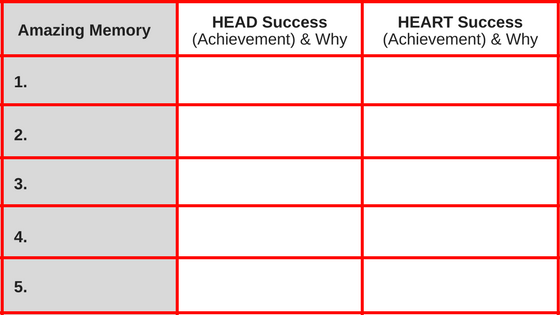
2. Notice which successes mean the most
Sometimes success only strikes a chord with your head, not your heart. At other times, you’ve probably managed to achieve both head and heart success simultaneously.
Action:
Fill out the 2nd and 3rd columns on the Amazing Memories grid. For each amazing memory, note if it gave you a deep sense of enjoyment (heart success) or a sense of achievement (head success)—or both. Note why.
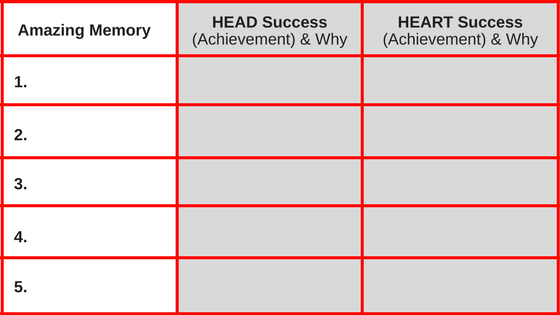
3. Discover what you would do if you had complete choice and freedom
Let your mind wander beyond the parameters of your current life by imagining the following scenario: You receive news that a long-lost relative has left you a $50 million inheritance. There are two strings attached:
- You must continue to work at least 30 hours a week, and be a contributing member of society.
- Your overall enjoyment of work and life must average at least eight out of 10, or the money vaporizes.
Action:
What activities and pursuits would you start doing (or do more often)? What activities and pursuits would you stop doing (or do less often)?
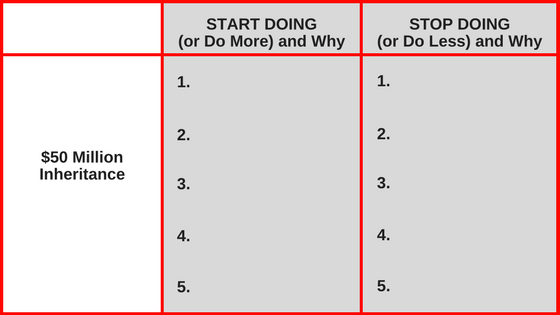
This is the third article in the Living an Amazing Life series. Other posts include:
Success: Achievement vs Fulfillment
If you’re like most leaders, you’re used to planning for achievement—or what I like to call ‘head success’. But this is only half of the equation. Head success is about reaching goals you set like revenue growth, profit, market share, personal wealth, possessions and vacations.
If you want a sense of satisfaction, you need to plan for enjoyment and fulfillment—aka ‘heart success’. This requires designing how you want to feel about yourself and your life when you wake up every day.
Everyone has their own definition of heart success. You may want to feel energized, influential and connected to people you love. You may want to feel like you are making a profound difference in the world, and evolving as a human being.
However you define it, you need to sort out what heart success is to you so it can be part of your game plan.
If you play your cards right, you’ll be able to look back, decades from now, with zero regrets. This is the true test of an amazing life.
Here’s a true story to think about until next week, when I’ll walk you through the first three of six steps to creating an amazing life plan.
Robert’s Story
By the time he was 36, Robert had made more money than any other person in the history of his family. He built his business from the ground up, and it could reasonably be called an empire.
For much of his career, Robert had an unstoppable focus on work, with the goal of accumulating wealth and security for his loved ones.
Trouble is, all Robert knew how to do was make money, and save money. His financial position was ridiculously solid, but he couldn’t bring himself to spend beyond the essentials—at all.
He dreamed of taking his family on vacations. He imagined buying pricey gifts for his kids. He longed for the day he would buy his hardworking, rough-and-tumble dad a new set of pipes for his Harley.
Robert had a generous heart, but he was so hard-wired to build wealth that, despite his best intentions, he couldn’t part with his cash.
Finally the day came when his father’s health faded, and it was clear he didn’t have long to live. And it changed everything. Robert spent $5,000 to buy that set of exhaust pipes, and his dad’s Harley never sounded louder, or felt more satisfying. His dad rode that upgraded bike only once before he died, but the joy he experienced gave Robert a whole new take on money. He finally understood he needed to expand his definition of success.
His whole life he had seen success through one lens: his wealth goals. All decisions were based on maximizing his financial position. He learned to methodically weigh enjoyment of life as part of his decision-making criteria. This may sound simple and obvious, but for many driven people like Robert, it’s a revelation.
Now, in addition to building wealth, Robert makes a concerted effort to create joy for himself and others. He bought the waterfront home he and his wife always wanted. He took his family on a trip around the world, and proudly owns a membership at a private track for car racing.
Sometimes that old perspective creeps up again, wanting Robert to pinch pennies and limit his enjoyment of life. When it does, he remembers his dad’s Harley, and switches to a broader perspective.
This is the second article in the Living an Amazing Life series. Other posts include:
Are you living an amazing life?
"Life is a great big canvas, and you should throw all the paint on it you can."
- Danny Kaye, actor
I have two questions for you – and be brutally honest with your answer:
- On a scale of 1 (low) to 10 (high), how good are you at enjoying life in tandem with your head success?
- Would you want someone you love to spend a lifetime living exactly as you are right now?
If your answer is not an enthusiastic, unqualified, ‘Heck yeah’, you’ve got work to do, my friend.
Life is meant to be a grand adventure. No one comes into this world only to have a booming business or legendary career. A truly amazing life is not just achievement...it’s enjoyment of your achievement. It’s enjoyment of life.
If you’re not shouting from the mountaintops about your life, don’t kid yourself into thinking you’ll suddenly feel deep joy when your business reaches a certain pinnacle. That’s not how life works.
Life Purpose
It’s easy to get addicted to success. Business achievement is a high that consumes many leaders—but it is not the only purpose in life. You deserve, and can have, a much larger sense of fulfillment; a sense that all aspects of your life are rewarding and satisfying. As a leader, it’s easy to lose sense of the bigger picture: to see nothing beyond hitting your next big goal.
High-achievers are incredibly hard on themselves – and often sacrifice themselves, and their personal lives, in the quest for success. It doesn’t have to be that way, so over the next month, we’re going to talk about what it takes to live an amazing life.
You need to work on this if...
- You rate your current enjoyment of life less than nine out of 10.
- You would feel you had used your life well, if it ended today.
- You tend to use up your passion for work, and have little left for the rest of your life.
- It’s not normal for you to look forward to things in your life.
- You often find yourself thinking or saying “woulda, coulda, shoulda”.
Join me for the next instalment of the Living an Amazing Life series when I explore the difference between the success in your head and your heart.
Annual Review and Your Goals for the Year
Hi! Just checking in to see how you are doing with your Annual Review and Master Plan for 2018.
Have you drafted your Master Plan – including your 2017 Annual Review and Plan for the Quarter?
Have you shared it with your team, family or friends?
It’s really important to take the time, to think about what you want to achieve in all areas of your life - Work, Self and Life – not just goals for the year, but for the rest of your well-lived life. And then to make sure the people you work with, and care about are on board
Here’s a link to the December blog about that – and let me know if you need any help.
Here’s to a truly sane and satisfying 2018!
Kevin
Your Master Plan
The tool that I want you to spend time on is My Master Plan which is broken down into three simple parts:
- Page 1 – The Annual Review: Questions to help you reflect on 2017: What was great, and what might make the next year better?
- Page 2 – The Master Plan: What the ultimate goal is for your lifetime? What would make things twice as good in three years, and what you want to achieve the coming year? The key is that this is done for the three key areas – Work, Self, Life. In fact, (once the initial madness settles down), the holidays are great time to do this exercise with your spouse family or friends – to work on your envisioned future together. Each of you can talk about what your ‘Self’ columns look like, so that you can support one another.
- Page 3 - The Plan for the Quarter: Starting with the amount of your passion ratio for each area, (how much energy you want to allocate for each area), and the #1 project or goal you want to achieve.
24/7 Project Lifecycle Rule
“Life is really very simple but we insist on making it complicated.” - Confucius
All too often when we work on project, we assume a one-week completion cycle - that things will get done in a week, and then we’ll talk about the next step.
As a result a lot of things don’t happen quickly.
I have a project lifecycle guideline I use with people I work with that makes life very simple – and helps to move things forward quickly.
It’s called 24 x 7, and it works like this: If we have a conversation today about a task, my default expectation is that it is done in 24 hours.
If it’s a more involved project that requires multiple steps, or working with other people, my default expectation is that it is done in 7 days - or by this time next week.
Most people don’t have a 24 x 7 project lifecycle rule. They have a 7 x 31 rule: get it done within a week – or a month.
Too often when I’m in meetings with leadership teams, their action items list gets bigger and bigger and bigger - because they think 7 x 31. As a result, it just takes longer and becomes bigger than it needs to be.
When you think 24 x 7 you only do what’s required to get it done, rather than making a task into a big complicated project. This is for regular ongoing, day-to-day business - obviously strategic initiatives don’t apply.





